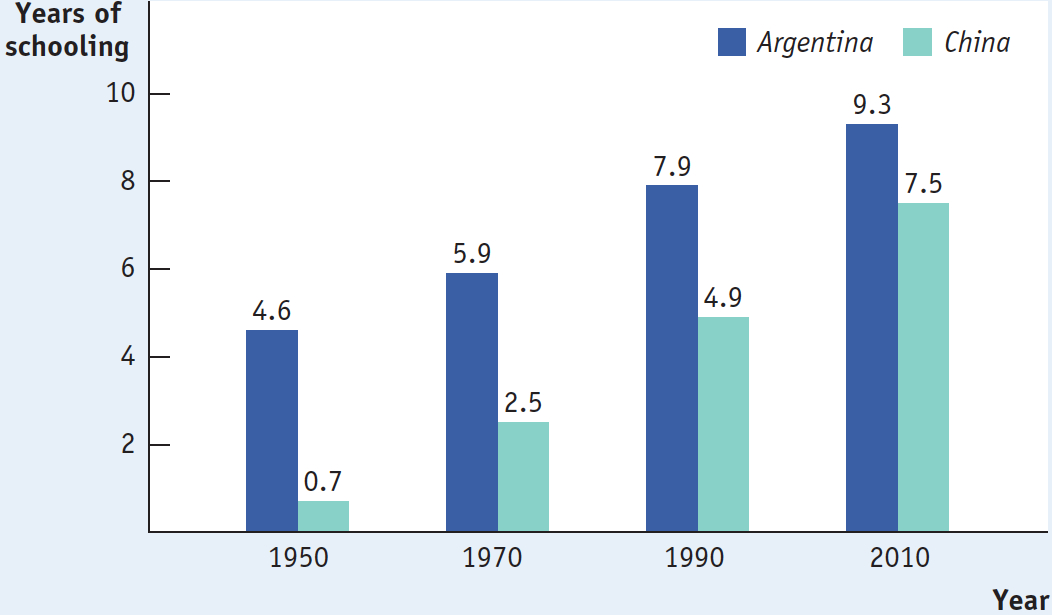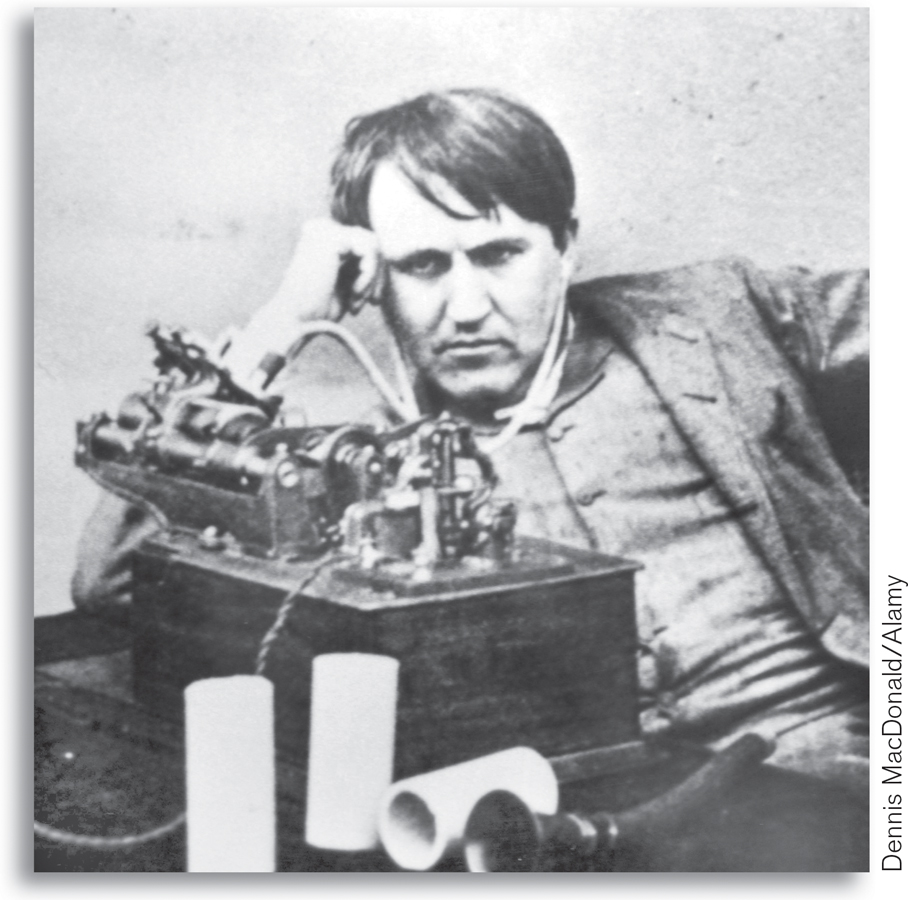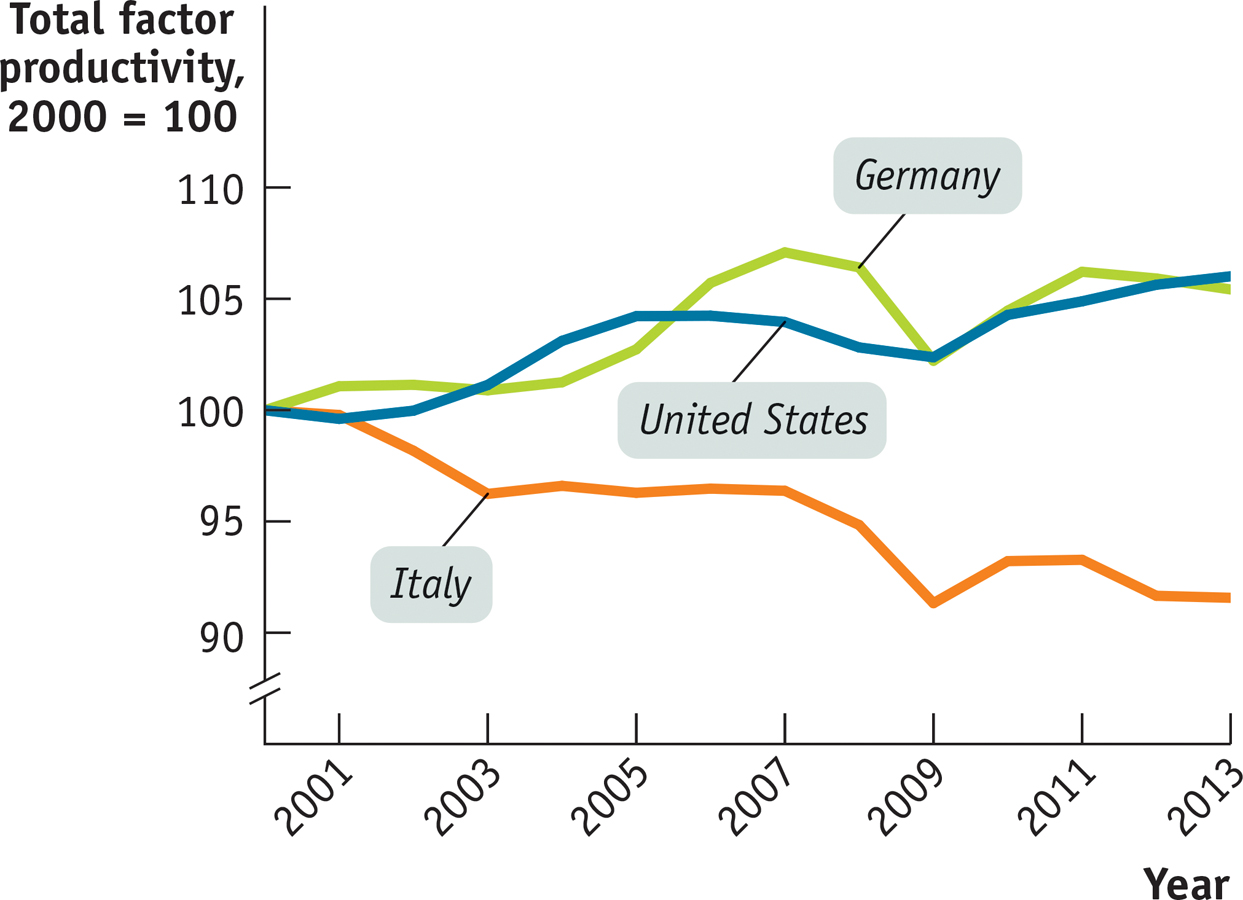Why Growth Rates Differ
In 1820, according to estimates by the economic historian Angus Maddison, Mexico had somewhat higher real GDP per capita than Japan. Today, Japan has higher real GDP per capita than most European nations and Mexico is a poor country, though by no means among the poorest. The difference? Over the long run—
As this example illustrates, even small differences in growth rates have large consequences over the long run. So why do growth rates differ across countries and across periods of time?
Explaining Differences in Growth Rates
As one might expect, economies with rapid growth tend to be economies that add physical capital, increase their human capital, or experience rapid technological progress. Striking economic success stories, like Japan in the 1950s and 1960s or China today, tend to be countries that do all three: rapidly add to their physical capital through high savings and investment spending, upgrade their educational level, and make fast technological progress. Evidence also points to the importance of government policies, property rights, political stability, and good governance in fostering the sources of growth.
Savings and Investment Spending One reason for differences in growth rates between countries is that some countries are increasing their stock of physical capital much more rapidly than others, through high rates of investment spending. In the 1960s, Japan was the fastest-
Where does the money for high investment spending come from? From savings. In the next chapter we’ll analyze how financial markets channel savings into investment spending. For now, however, the key point is that investment spending must be paid for either out of savings from domestic households or by savings from foreign households—
Foreign capital has played an important role in the long-
One reason for differences in growth rates, then, is that countries add different amounts to their stocks of physical capital because they have different rates of savings and investment spending.
Education Just as countries differ substantially in the rate at which they add to their physical capital, there have been large differences in the rate at which countries add to their human capital through education.
A case in point is the comparison between Argentina and China. In both countries the average educational level has risen steadily over time, but it has risen much faster in China. Figure 9-7 shows the average years of education of adults in China, which we have highlighted as a spectacular example of long-
9-7
China’s Students Are Catching Up

Research and Development The advance of technology is a key force behind economic growth. What drives technological progress?
Scientific advances make new technologies possible. To take the most spectacular example in today’s world, the semiconductor chip—
Research and development, or R&D, is spending to create and implement new technologies.
But science alone is not enough: scientific knowledge must be translated into useful products and processes. And that often requires devoting a lot of resources to research and development, or R&D, spending to create new technologies and apply them to practical use.
Although some research and development is conducted by governments, much R&D is paid for by the private sector, as discussed below. The United States became the world’s leading economy in large part because American businesses were among the first to make systematic research and development a part of their operations. The upcoming For Inquiring Minds describes how Thomas Edison created the first modern industrial research laboratory.
Developing new technology is one thing; applying it is another. There have often been notable differences in the pace at which different countries take advantage of new technologies. For example, as the following Global Comparison shows, since 2000, Italy has suffered a significant decline in its total factor productivity, while the United States and Germany have powered ahead. The sources of these national differences are the subject of a great deal of economic research.
Inventing R&D
Thomas Edison is best known as the inventor of the lightbulb and the phonograph. But his biggest invention may surprise you: he invented research and development.

Before Edison’s time, there had, of course, been many inventors. Some of them worked in teams. But in 1875 Edison created something new: his Menlo Park, New Jersey, laboratory. It employed 25 men full time to generate new products and processes for business. In other words, he did not set out to pursue a particular idea and then cash in. He created an organization whose purpose was to create new ideas year after year.
Edison’s Menlo Park lab is now a museum. “To name a few of the products that were developed in Menlo Park,” says the museum’s website, “we can list the following: the carbon button mouthpiece for the telephone, the phonograph, the incandescent lightbulb and the electrical distribution system, the electric train, ore separation, the Edison effect bulb, early experiments in wireless, the grasshopper telegraph, and improvements in telegraphic transmission.”
You could say that before Edison’s lab, technology just sort of happened: people came up with ideas, but businesses didn’t plan to make continuous technological progress. Now R&D operations, often much bigger than Edison’s original team, are standard practice throughout the business world.
 | What’s the Matter with Italy? |
In the preceding Economics in Action, we described the ongoing debate over the state of technological progress. Will information technology lead to sustained growth, or is it already past its prime? Nobody really knows. One thing does seem clear, however: some countries have been much more successful at making use of new technologies than others.
In the early stages of the information technology, or IT, revolution, it seemed that the United States was pulling ahead of Europe. That’s less clear now: some European countries have moved forward rapidly in broadband, the wireless internet, and more. But one major European nation is clearly lagging on all fronts: Italy.
The accompanying figure shows estimates of total factor productivity growth since 2000 in three countries: the United States, Germany (Europe’s largest economy), and Italy. The United States and Germany have been roughly keeping pace. But Italy seems, remarkably, to have actually been slipping backwards.
This may be, in part, a consequence of the continuing economic slump in Europe. But researchers studying Italian business argue that a variety of institutional factors, ranging from rigid labor markets to poor management, have prevented Italy from taking advantage of the opportunities new technology has to offer.
It’s a troubling picture, and one that surely should be addressed with a variety of economic reforms. Unfortunately, Italy’s troubles aren’t just economic: it also suffers from chronic political weakness, which has left successive governments with little ability to take strong action on any front.

Source The Conference Board Total Economy Database™, January 2014, http:/
The Role of Government in Promoting Economic Growth
Governments can play an important role in promoting—
Government Policies Government policies can increase the economy’s growth rate through four main channels.
Roads, power lines, ports, information networks, and other underpinnings for economic activity are known as infrastructure.
1. GOVERNMENT SUBSIDIES TO INFRASTRUCTURE Governments play an important direct role in building infrastructure: roads, power lines, ports, information networks, and other large-
Poor infrastructure, such as a power grid that frequently fails and cuts off electricity, is a major obstacle to economic growth in many countries. To provide good infrastructure, an economy must not only be able to afford it, but it must also have the political discipline to maintain it.
Perhaps the most crucial infrastructure is something we, in an advanced country, rarely think about: basic public health measures in the form of a clean water supply and disease control. As we’ll see in the next section, poor health infrastructure is a major obstacle to economic growth in poor countries, especially those in Africa.
2. GOVERNMENT SUBSIDIES TO EDUCATION In contrast to physical capital, which is mainly created by private investment spending, much of an economy’s human capital is the result of government spending on education. Government pays for the great bulk of primary and secondary education. And it pays for a significant share of higher education: 75% of students attend public colleges and universities, and government significantly subsidizes research performed at private colleges and universities. As a result, differences in the rate at which countries add to their human capital largely reflect government policy. As we saw in Figure 9-7, educational levels in China are increasing much more rapidly than in Argentina. This isn’t because China is richer than Argentina; until recently, China was, on average, poorer than Argentina. Instead, it reflects the fact that the Chinese government has made education of the population a high priority.
3. GOVERNMENT SUBSIDIES TO R&D Technological progress is largely the result of private initiative. But in the more advanced countries, important R&D is done by government agencies as well. For example, the internet grew out of a system, the Advanced Research Projects Agency Network (ARPANET), created by the U.S. Defense department, then extended to educational institutions by the National Science Foundation.
4. MAINTAINING A WELL-
If a country’s citizens trust their banks, they will place their savings in bank deposits, which the banks will then lend to their business customers. But if people don’t trust their banks, they will hoard gold or foreign currency, keeping their savings in safe deposit boxes or under the mattress, where it cannot be turned into productive investment spending. As we’ll discuss later, a well-
The New Growth Theory
Until the 1990s, economic models of technological progress assumed that what drove innovation was a mystery—
At any point in time, an economy has a stock of knowledge capital—
Yet, as Romer pointed out, there is a severe wrinkle in this story: because knowledge is shared throughout the economy, it may be very difficult for an innovator to capture the rewards of his or her innovation as others exploit the innovation for their own interests. So in the New Growth Theory, government protection of intellectual property rights is critical to furthering technological progress. In addition, governments, institutions, and firms can enhance technological progress by subsidizing investments in education and research and development, which, in turn, can increase the stock of knowledge capital.
By giving us a better model of where technological progress comes from, the New Growth Theory makes clear how important the policies of government, institutions, and firms are in fostering it.
Protection of Property Rights Property rights are the rights of owners of valuable items to dispose of those items as they choose. A subset, intellectual property rights, are the rights of an innovator to accrue the rewards of her innovation. The state of property rights generally, and intellectual property rights in particular, are important factors in explaining differences in growth rates across economies. Why? Because no one would bother to spend the effort and resources required to innovate if someone else could appropriate that innovation and capture the rewards. So, for innovation to flourish, intellectual property rights must receive protection.
Sometimes this is accomplished by the nature of the innovation: it may be too difficult or expensive to copy. But, generally, the government has to protect intellectual property rights. A patent is a government-
Political Stability and Good Governance There’s not much point in investing in a business if rioting mobs are likely to destroy it, or in saving your money if someone with political connections can steal it. Political stability and good governance (including the protection of property rights) are essential ingredients in fostering economic growth in the long run.
Long-
Americans take these preconditions for granted, but they are by no means guaranteed. Aside from the disruption caused by war or revolution, many countries find that their economic growth suffers due to corruption among the government officials who should be enforcing the law. For example, until 1991 the Indian government imposed many bureaucratic restrictions on businesses, which often had to bribe government officials to get approval for even routine activities—
Even when the government isn’t corrupt, excessive government intervention can be a brake on economic growth. If large parts of the economy are supported by government subsidies, protected from imports, subject to unnecessary monopolization, or otherwise insulated from competition, productivity tends to suffer because of a lack of incentives. As we’ll see in the next section, excessive government intervention is one often-
!worldview! ECONOMICS in Action: Why Did Britain Fall Behind?
Why Did Britain Fall Behind?
It’s one of the classic questions in economic history: Why did Britain, the home of the Industrial Revolution, by far the world’s leading economy for much of the nineteenth century, end up falling behind other nations at the start of a new century? It’s not a tragic story: the British economy continued to grow, and it remained a rich country by international standards. Still, by the early twentieth century it was obvious that British industry was no longer at the cutting edge. Instead, the United States and Germany had come to supplant Britain as the new economic frontier. What happened?

That’s not an easy question to answer. Robert Solow, an MIT economics professor and Nobel laureate who pioneered the theory of economic growth, once memorably declared that all efforts to explain Britain’s lag end in “a blaze of amateur sociology.” Indeed, among the reasons often given for the lag are such things as the excessive influence of the landed aristocracy, social barriers that prevented talented individuals from the wrong class from rising, and a cult of amateurism that was good enough for people running small family firms but not for the managers of large modern corporations.
There were, however, other factors in Britain’s relative decline that were more easily measured. Of special importance was education. Britain was much slower than other industrial countries, the United States in particular, to establish universal basic education. Moreover, its universities, for all their ancient glories, remained too focused on preparing young gentlemen for their role in society; college education was for a long time restricted to a narrow segment of the population. And Britain was late in developing the close ties between academics and industry that did so much to drive the Second Industrial Revolution in both America and Germany. These barriers to education and skill acquisition placed Britain at a human capital disadvantage.
The good news for today’s British residents is that most of these problems lie well in the past. Currently, young Britons are slightly more likely than their American counterparts to receive a college education. British real GDP per capita is still below U.S. levels, but it has made up part of the gap. And nobody walking around London today would consider it a backward-
Quick Review
Countries differ greatly in their growth rates of real GDP per capita due to differences in the rates at which they accumulate physical capital and human capital as well as differences in technological progress. A prime cause of differences in growth rates is differences in rates of domestic savings and investment spending as well as differences in education levels, and research and development, or R&D, levels. R&D largely drives technological progress.
Government actions can promote or hinder the sources of long-
term growth. Government policies that directly promote growth are subsidies to infrastructure, particularly public health infrastructure, subsidies to education, subsidies to R&D, and the maintenance of a well-
functioning financial system. Governments improve the environment for growth by protecting property rights (particularly intellectual property rights through patents), by providing political stability, and through good governance. Poor governance includes corruption and excessive government intervention.
9-3
Question 9.7
Explain the link between a country’s growth rate, its investment spending as a percent of GDP, and its domestic savings.
A country that has high domestic savings is able to achieve a high rate of investment spending as a percent of GDP. This, in turn, allows the country to achieve a high growth rate.
Question 9.8
U.S. centers of academic biotechnology research have closer connections with private biotechnology companies than do their European counterparts. What effect might this have on the pace of creation and development of new drugs in the United States versus Europe?
It is likely that the United States will experience a greater pace of creation and development of new drugs because closer links between private companies and academic research centers will lead to work more directly focused on producing new drugs rather than on pure research.
Question 9.9
During the 1990s in the former Soviet Union a lot of property was seized and controlled by those in power. How might this have affected the country’s growth rate at that time? Explain.
It is likely that these events resulted in a fall in the country’s growth rate because the lack of property rights would have dissuaded people from making investments in productive capacity.
Solutions appear at back of book.